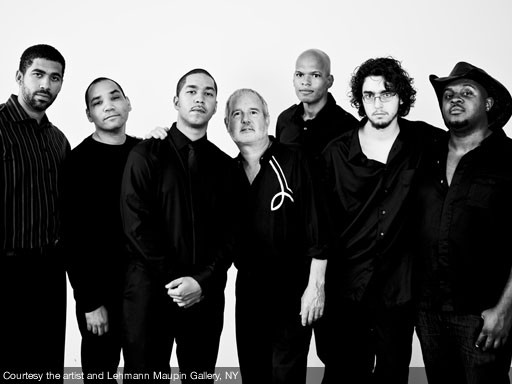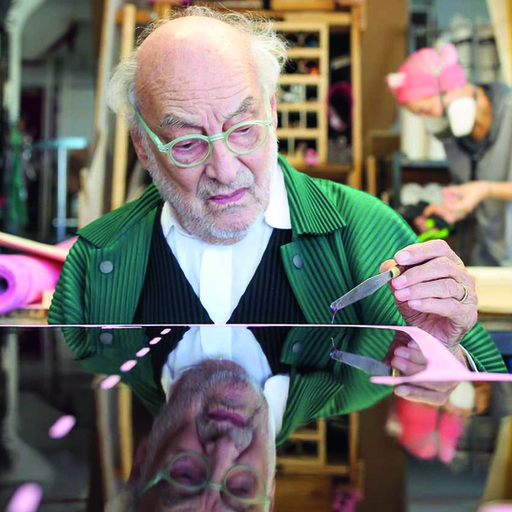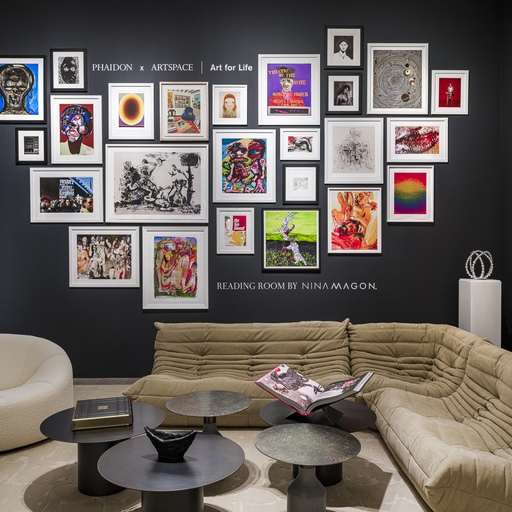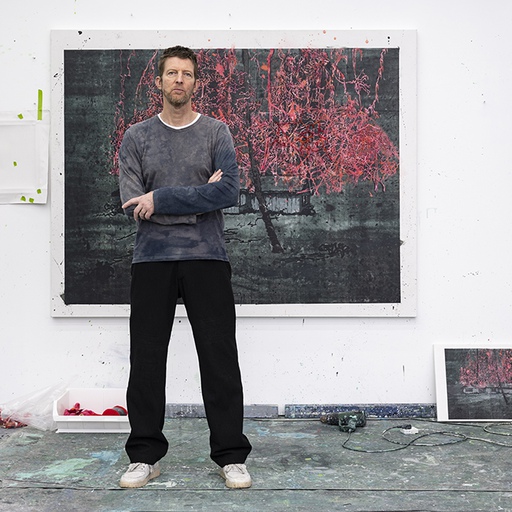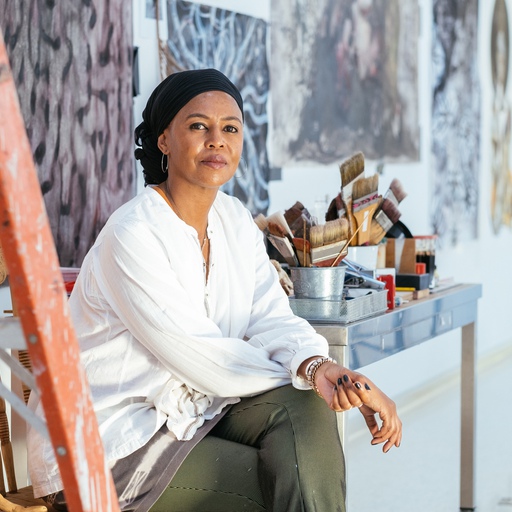For over three decades, the artist Tim Rollins has been creating extraordinary work with K.O.S., a collective of young at-risk middle-school students from the South Bronx and assorted volunteers from around the world. Taking inspiration from classic works of literature and music that Rollins imparts to his students, the art ranges over a wide variety of mediums-from sculpture to large-scale paintings to drawings—and always contains a reference to the source text, for instance by being painted or drawn over its pages. Featured in the Venice Biennale in 1998 and two Whitney Biennials, Rollins and K.O.S. have now been commissioned to bring an open-air studio to Randall's Island for this weekend's Frieze NYC art fair, exhibiting their radical approach to art to a broad audience.
To mark this occasion, Artspace is offering two unique works by the artists, one of them a lyrical version of the painting they will be making on-site at Frieze and the other an intensely powerful tribute to a K.O.S. student who was murdered in 1993. To learn more about the collective's work, Artspace editor-in-chief Andrew M. Goldstein spoke to Rollins about the open studio, his inspirations, and how he and K.O.S. managed to make history through art.
So, tell me about your installation at the fair.
Well, it's an open-studio project that's outdoors. We know Randall's Island because none of my kids at K.O.S. have backyards, so this is the park for a lot of southeast Harlem kids, it's their backyard. Our site is wonderful, it's in this glen of oak trees right on the water. You're going to see me jumping up and down with my microphone and working with the kids, and we're actually going to be constructing a painting in public based on A Midsummer Night's Dream after William Shakespeare and Felix Mendelssohn. That series is already pretty well known, but this will be the first time that we make the work in public, and so many people just can't figure it out, saying, "Wow, how did you make that?" And whatever children or young people who want to come can come and help out. The whole thing looks terrific. It's a little moist and wet. It could end up being like Woodstock 2. I missed it the first time—my mom wouldn't let me go [laughs]. But it's the second time I've ever made a work in public—the first time was the Institute of Contemporary Art in Boston in 1988.
What was that experience like in Boston?
We made an Amerika painting, and I swore that I'd never do it again because the kids are great but the adults were driving me crazy asking, "What is this all about?" And I was so earnest and eager in those days and I would actually sit there and give a little tutorial about what we were doing. So now all I say is "Google me" and I turn my back [laughs]. But also working in public is kind of risky—not many artists do this, so I hope it works out. So I'm very, very excited. And it's going to be like a big family reunion, because a lot of former students—and I've taught hundreds of kids in the South Bronx—are going to come, and now they're older and they've got their own kids. And I'm a professor at the School of Visual Arts and I'm teaching grad school at Yale, so a lot of those students are going to come too. It's going to be a hootenanny. No, it's going to be like a Pentecostal tent revival meeting, that's what it's going to be like. I've got a lot of hillbilly Baptist preacher in me, so I'm thrilled. And as long as I have fun that's all that counts really.
How big is the painting and what is it going to be painted on?
The painting is not huge, but it's about 72 by 54 inches and our work is always on printed archival book pages or music score pages of classics. So it's going to be on Mendelssohn's great overture for The Midsummer Night's Dream, which he wrote when he was 16 years old. It's our inspiration, and the music will be blasting. What's nice is that we have a beautiful score that also incorporates the text of Shakespeare, and what I've asked the young people to do is that I want them to assume the identity of the character Puck—Puck the changeling, Puck the knucklehead, Puck the special ed kid, Puck the one who always gets sent to the principal's office, Puck who loves to change things for just the sheer joy of transmutation. So what I ask kids to do is that I say, "Listen, I want you to imagine a flower that has the power to make you fall in love with the first living thing you see upon awakening." It's straight from the play—that's what Puck's job is, to find this magic flower. But we don't do tulips, we don't do roses, we don't do daisies. What we do is we come up with these bizarre, phantasmagorical flowers and we paint them with watercolors and acrylic inks on this beautiful, exotic Thai mulberry paper. So everything sort of fits the theme—it's hilarious, we're even in the woods. We'll all become Puck on this big, 30-foot-long table in an open-air workshop, and people will get to see how we do it and the kids will get to meet all the older members of the group. We've got Angel [Abreu] here right now, he's 37 and he's been working with me since he was 11 years old, and we have the older members here and they're bringing their kids, so we have three generations represented here in the K.O.S. project. It's one big fan-damily.
Tell me about the process of your work, from conceiving the idea to explaining it to your students to having it actually be executed.
A lot of it, to be honest, is almost like jazz—there's a lot of trial and error, and we improvise and we come up something that needs to be exciting and has to be a genuine mystery. For example, tell me: "What does a flower look like that makes you fall in love with the first living creature you see upon awakening?" Well guess what? Your teacher can't tell you, your mom can't tell you, your girlfriend or boyfriend can't tell you. It has to be summoned from the imagination. And what is interesting to me is the call and response in the Baptist church—the call is the score, the music, or what we call the inspirational text, and our response is what ends up on the canvas. This tends to be a very long process, and once we get going and we make a lot of junk we always have one of those "eureka" days when some little kid, or it could be me or it could be Angel or Rick or Eric, goes, "Whoa, what about this?" And then, boom, we get the idea, and we all adapt it for ourselves. So it's quite beautiful. And it takes patience, patience, patience. You need to make tons of trash to get to your treasure.
Where did you get the idea for this process
Well, I came to New York to study with John Cage, and I learned so much from John because in a chance operation, when you do something 400 times, something's going to hit. Also, what's beautiful about this is that there's no failure so the pressure's off—in other words, yeah, go ahead, mess up, let's go. Let's have fun, let's experiment. And eventually something takes hold and that becomes the theme of the work and we have a structure from which we can make something of enduring excellence.
How long does it typically take to get from the first draft to the final product?
Well, if we stick to A Midsummer Night's Dream, that took two years to kind of get it going. And what really instigated it was in 1999 I was invited to the University of Albany's art museum to do a workshop, and they were having a Shakespeare semester. The work was always in the back of my head, and this was at a time when nothing was selling and we didn't have a gallery, so I had to work five jobs to keep the studio open and volunteer—it was a rough time. So when they asked me to do this workshop for few week I was like, "I'm there like white on rice." And I had no idea what we were going to do, so even after two weeks of the workshop when the school said, "We need to know what you're doing," I said, "Oh, but I want it to be a surprise." But speaking to students during this Shakespeare semester I thought I should check out this book of Shakespeare's quotations and see if anything hits me. What was it going to be, Macbeth with specks of blood and daggers? What were they going to do? And I caught that wonderful quote from A Midsummer Night's Dream—and I think it's the greatest quote about art in the English language—where Theseus, who is the king of Athens, is talking about art and says, "And, as imagination bodies forth/ The forms of things unknown, the poet's pen/ Turns them to shapes, and gives to airy nothing/ A local habitation and a name." That knocks my socks off to this day. So the notion of the kids being Puck and creating this magic flower just took off. And it became obvious that we had a much larger series of works, and we've been doing that for, wow, the past 10 years now, working with different communities all over the world.
What is the age range of the kids you typically work with?
Well, I just finished working in Bangor, Maine, and my youngest kid there was eight and my oldest was 40. Basically anybody can sign up, though for this Frieze project we're restricting it to the youth, because sometimes you can get these bitter, unsuccessful artists who are assholes and want to come in and sabotage the project. But I've got good radar for that kind of person. Also, we've got like 20 pretty tough—looking Dominican dudes from the group, and they're not going to allow any disturbances. This is for the kids. I don't do cutoff things, it doesn't feel right, but I'm thinking the top will be about 15 because you don't want any adults—they rain on the parade and they spoil the broth, especially the helicopter parents. I say, "You had your chance, let us enjoy ourselves."
As an artist working with these kids, where does your hand evidence itself?
Oh, I'm in it! I'm almost like… I love black Baptist choirs and gospel music, and I just love it when the choir director picks up the mic and just lays it out spontaneously. That's what I'm like. I'm the director, and I'm the one responsible for coordinating everybody's voices, but I can also pick up the mic and tear it up. I'm like Joe Torre with the Yankees, except that I can go out there and hit a home run if they really need one. And trust me, they should have let him do that once in a while. So I'm in there—I'm not just sitting there in the director's chair yelling out with a bullhorn, "Make this red and that orange."
How do you feel your work with K.O.S. has been received by the art world at large?
Generally? With a combination of skepticism, cynicism, but ultimately acceptance and joy. And I think that's what happens when you do this for 30 years and you prove that you're not just some gimmick, and it's not just some feel-good UNICEF project. We're not UNICEF, we're a very serious family that happens to make art together. And I get a lot of art historians who say, "If you look at it, Tim Rollins and K.O.S. is the longest-enduring artist collective in the history of art." Outside the couples like Gilbert & George and Jeanne-Claude and Christo and people like that. And you know what? I feel they're kind of right. And we've just started.
And you've been in the Venice Biennale, at Documenta, at the Dia Art Foundation….
Yeah, and we're in 97 museum collections worldwide, which is what I'm most excited about. Also I'm very excited that many of the kids who have gone through K.O.S. have followed me into education, and they're teaching at Columbia, at Stanford, and at public schools all over the place. We have a new person who just joined this week, Eric Fernandez, who was one of my students at SVA—he's Puerto Rican, he's from the South Bronx—and he said, "I need you." And I said, "I'm sorry?" And he said, "No, I just read about you, I saw the movie about you, I read the book about you, and I'm just telling you, man, I need you. I want to be a teacher, won't you mentor me?" He's with me right now. I hope I don't ruin him.
You're famous for announcing to your students that "today we're going to make art, but we're also going to make history," and I wonder, what do you mean by that? What kind of history? Art history?
I really mean that. I'm not being arrogant. But we've made art history already. Once you've got five things at MoMA, that's it. But I want to make history in terms of community. I want to make history in terms of my young folk having the values and mores to be a responsible and contributing citizen in the world. I'm very corny, and it's really about building some new kind of cultural democracy, and I think it's really, really important. I think what we've done is that we have challenged elite notions of fine art that put boundaries on who can appreciate art, who can make art, and who can feel the impact of that art. I think that is our biggest collective achievement.
And some of the kids you work with have reading difficulties and learning disabilities.
Yeah, so-called "disabilities." There are no disabilities, there are just different abilities. I don't even use the word "disability." Because, you know, they can draw like dreams but they might have trouble reading. You know, I'm trained in being a special-ed educator, and I was an assistant teacher for 10 years in the South Bronx, starting in 1980. And I worked in junior high school in special-ed care. People don't know this. Seven in the morning to 3 p.m. in the afternoon at least, and I had the most difficult kids in the most difficult neighborhood under the most difficult circumstances, since it was the 1908s and the Bronx was burning, literally. What was wonderful was that I could discern their gift, their talent, and their enthusiasm for art—they all hated school but they loved art, so I went through art to make them love knowledge. School maybe could come later [laughs]. I don't equate school with knowledge. So the potential was huge.
Public art funding is being cut across the board right now, and more cuts are gravely threatened. What impact has this had on what you do?
None, because it's all me. We are independent and we are Libertarian. As I've always said, you've got to make your own money. So that means that we started out with very generous grants from the National Endowment for the Arts, but once we had that seed money and once we got going it became imperative that we make our own money. We are totally independent of any state, federal, or city funding whatsoever. We are a for-profit corporation with a nonprofit arm, because other universities and organizations can raise money to have me and K.O.S. come out and do special projects, so that's wonderful as well. But we operate on a lot of funds. We're free.
There are many notable artists whose teaching has become a major part of their legacy, from Walter Gropius and the Bauhaus to Josef Albers at Yale and Hans Hoffman and the Black Mountain School and now someone like Hans Haacke at Cooper Union. How do you see yourself fitting into that tradition?
As a continuation. But what's interesting is that I don't come into the classroom as some sort of master. K.O.S. is an institution that we created for ourselves, it's organic. Whereas I am a distinguished professor at Yale University and I teach at the School of Visual Arts and the Academy of Fine Arts in Toronto, and I will be the resident professor for this amazing project that will be at the University of Massachusetts at Amherst celebrating the life and legacy of the great African-American philosopher W.E.B. DuBois. And that just knocked my socks off—I'm a DuBoisian. So that's another type of practice, it's a different sort of situation, and I'm not going to be making collaborative artworks with my advanced students, because their job is to get their own practice together. And another thing is that every single person in K.O.S. is an individual artist on their own—one is a painter, one is a photographer, one is a graphic designer. And that's really important, because otherwise it's like a cult or something weird. And I love the fact that the work they make doesn't look anything like what K.O.S. makes, so that's great.
Do you make your own art outside of K.O.S.?
[laughs] There's not one second left. So no, but I'm a choir singer and I'm dying to write poetry. Literally to keep everything going takes everything I've got. It would be like asking Leonard Bernstein to conduct an orchestra all by himself—it would look a little crazy. But anything's possible.
When was the last time that you made something that was just a Tim Rollins artwork?
I haven't done it, ever. Although it could change—tomorrow I could get an idea and put my name on it as an individual practice. That hasn't occurred yet. It's a conundrum, it's an issue, trust me. But, you know, most artists' idea of heaven is my idea of hell. Most artists' idea of heaven is to be alone for 16 hours a day, working alone in their studio, and that's beautiful for them. I go crazy if I'm all alone and I can't wait until I'm with everyone else in the studio. It's like being in a band—I'm not a solo musician.
Now, we have one of the works in your Invisible Man series with the letters "I" and "M" overlaying the text, and they have a striking graphic sensibility that is different from the handmade feeling present in much of your work. Can you talk about these pieces?
Yeah, but we always operate on two principles—it's like a pendulum. You have to understand that it's collaborative conceptually as well as physically. So the idea for the Invisible Man paintings came collectively after years and years and years, and the new ones are wonderful—they have negative space, they are pretty radical, and we're very excited about them.
What was the idea that someone suggested that made everyone else say, "That's the right idea, that's the way to approach it"?
Well, here's the story. We were suffering from the murder of our favorite kid, Christopher Hernandez, who was shot at the age of 14. He was an innocent bystander in a murder that killed six people, and he saw the murder. Our minds were blown. And we were looking at one of the newspaper articles about the massacre—this was in 1993—and George, his best friend, who ended up going to Bard, saw this big article in the New York Post with the tabloid headline "MURDER VICTIM," and what he did was cut out the "IM" from "VICTIM." That's why it has a very graphic quality—it looks like a tabloid. So it was really about taking that notion of being a victim and applying it to Ralph Ellison's great novel Invisible Man, which we had been trying to work on for years. And it related to a great placard that the Memphis sanitation workers held after Martin Luther King, Jr.'s assassination and that Ernest Withers captured in his famous photograph that says "I AM A MAN." Then, of course, the different color blues come from each participant who chooses their own color, so it's a self-portrait in blue. It's pretty beautiful. The first Invisible Man painting was 12-feet-by-12-feet, and we showed it in 2000 at Baumgartner Gallery in Manhattan. That's how that happened. One of them is now in the collection of the Memphis Museum of Art, and that's pretty powerful because that's where King was assassinated.
I've read that your work was inspired from early on by Arte Povera, the 1960s Italian art movement that used humble materials to make beautiful conceptual artworks. Can you talk about that a little?
Yeah, it was a huge influence. I just came back from the Pier Paolo Calzolari show at Marianne Boesky and Pace, and I was in tears. The funny thing is that the kids in K.O.S. are really poor. It isn't just about the materials. We're making art in literally the poorest congressional district in the United States, per capita, and look at the beauty, look at the joy, look at the effervescence. So that was my great inspiration in terms of radical use of materials and no boundaries and installation. A huge, huge influence on me. And I like the politics of it, seeing the beauty in the humble. I always tell my students that learning to be an artist is dress rehearsal for learning to be people, so don't get tied up. And I think that is what we have done over 30 years of practice.
In Depth
Tim Rollins of K.O.S. on Making History Through Art
